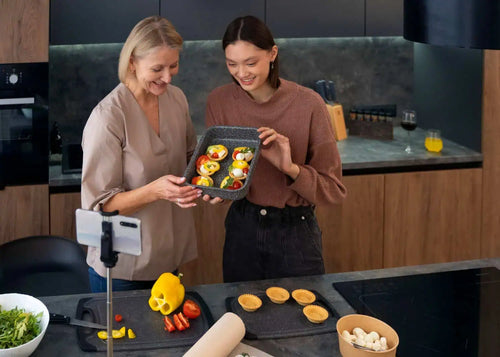Make Traditional Indian Food Using Modern Kitchen Appliances

Indian food is as much about its rich traditions and methods as the taste. We all have memories of food, the stories behind the recipes, and food traditions passed on by generations. What is the first thing that comes to your mind about traditional Indian food? It will probably be an age-old delicious recipe made by your grandma using traditional cooking methods. Today, we might not have the time to use a hand mixture to grind pastes or to cook on open flames, so we have shifted to electric mixtures and gas stoves. But one common thing remains- food is cooked with love and warmth. Using modern appliances, we can make the same traditional rich food, but the effort and time are saved. This also makes it easy for the younger generation to adapt to and take more interest in making traditional Indian food.
Evolution of Indian Cooking Within Modern Families
Traditional Indian food has a rich history and is made with a lot of effort, time, and love. In the modern age, having that much time to cook food is probably not possible for everyone. While everyone enjoys eating traditional food, it takes time and effort to cook it. With ready-to-eat food packs, takeaways, and dining out becoming famous, cooking at home has reduced.
Along with being tasty, traditional Indian food is also packed with all the necessary nutrients and is a balanced diet, leading to a better lifestyle. So, to preserve Indian recipes and cooking, adapting modern technology is important. By using kitchen appliances, we not only save time and effort, but we can also continue making the same delicious food more often and efficiently. This mix of new-age appliances and equipment to make traditional food is a great way to preserve our traditions and eat nutritious meals.
Evolution of Traditional Indian Cooking Techniques: Adapting to Modern Appliances
Modern Appliances have made traditional cooking more convenient, saving time and energy. By adapting the latest technology, traditional cooking techniques have evolved and become more suitable for the modern age.
- Tandoor Oven to Electric Oven: Traditionally, a clay or tandoor oven was used to make naans/Indian bread and roast meats and kebabs. Using a clay oven requires the right temperature control and techniques. However, using an electric oven allows the same things to be made at home at a controlled temperature and with consistent taste and flavors.
- Hand Grinding to Mixer Grinders: Many old Indian recipes involve grinding herbs, grains, etc., using a mortar or hand pastel. These methods give better flavors and texture but are extremely time-consuming and require manual labor. The same herbs and grains can easily be ground in an electric mixture, and the flavors remain the same.
- Open Flame Cooking to Gas Stoves: Open cooking became a tradition due to the unavailability and high cost of gas stoves. But cooking on an open flame means cooking outdoors, regularly monitoring the heat, and taking longer to cook. Gas stoves are easily installed in the kitchen, the temperature can be regulated, and cooking is fast.
- Slow Cooking to Pressure Cooking: Slow-cooking dals, meats, and curries is an age-old tradition in Indian cooking. However, the process takes up a lot of time. Pressure cooking gives the same taste and flavor in less than half the time.
- Manual Kneading to Automated Roti Makers: The most technical and fundamental aspect of Indian cooking is kneading the dough to make rotis, naans, and parathas. Kneading dough consumes much time and labor, as does making the rotis. One revolutionizing technology is automated roti makers, like Rotimatic. It automates the entire process, from kneading the dough to making varieties of Indian breads. You don’t have to worry about rolling round rotis, either!
A Modern Twist on an Ancient Tradition: The Rotimatic Advantage
Many modern kitchen appliances, like the pressure cooker, electric mixture, etc., are making life and cooking easier. Still, one appliance stands out and has completely changed the game for home-cooked food. The Rotimatic takes comfort, ease, and speed a step ahead of other kitchen appliances. Until a few years ago, making rotis with a machine was hard to imagine. Since kneading the dough and making rotis are complex procedures, they require expertise and technique. The quantity of ingredients like flour, water, oil, etc., also plays a vital role in making rotis. Also, the size and thickness of rotis and the type of dough used differ from family to family.
Rotimatic is designed to make the complex and diverse process of making rotis simplified and quick with minimal user assistance. On average, it would take around 30 minutes to make rotis, which can be reduced to less than 10 minutes using a Rotimatic. And the rotis come out just as delicious and exactly to your taste and liking! Rotimatic is one of the best examples of bringing traditional Indian recipes and modern technology together. This fusion helps you enjoy your traditional food and, at the same time, saves you time and effort without compromising on authenticity. So, you do not have to give up on your roots due to your busy schedules, and the need to order in or takeaways is reduced. Family recipes are always special and make us happy and nostalgic while making and eating them; they also help us preserve our culture and history.
Rotimatic helps you stay connected with your roots of traditional Indian food while ensuring that you do not waste a lot of time preparing the food and enjoy a nice hot meal with fluffy rotis at the end of a long day.
The best fusion of traditional methods and the latest technology: Rotimatic! You are just a click away from effortless round rotis.